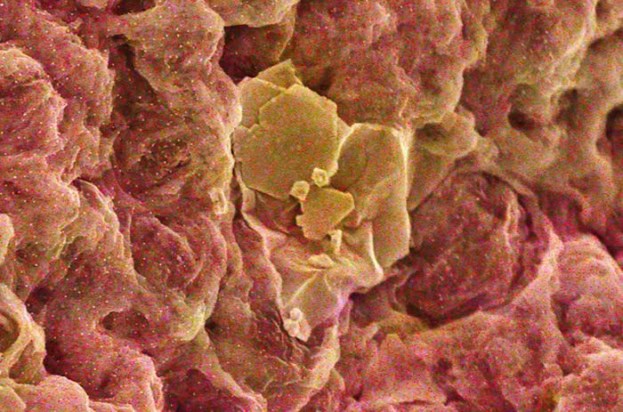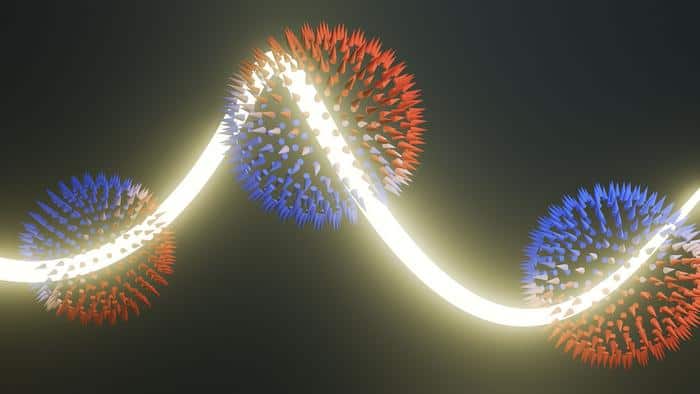


Experimental observations at the Swiss Light Source could advance the development of energy-efficient memory devices based on "orbitronics"
Applied voltage adjusts intensity at twin focal points
 Read article: Spiders use physics, not chemistry, to cut silk in their webs
Read article: Spiders use physics, not chemistry, to cut silk in their webs
New work resolves a longstanding debate and could aid the development of new cutting tools
 Read article: Quantum material detects tiny mechanical strains
Read article: Quantum material detects tiny mechanical strains
Sensitivity of vanadium-oxide-based device breaks previous record by more than an order of magnitude
 Read article: Aluminium oxide reveals its surface secrets
Read article: Aluminium oxide reveals its surface secrets
New non-contact atomic force microscopy images shed more light on the "enigmatic insulator" aluminium oxide
 Read article: Silk-on-graphene films line up for next-generation bioelectronics
Read article: Silk-on-graphene films line up for next-generation bioelectronics
Researchers have grown a uniform two-dimensional layer of silk protein fragments on a van der Waals substrate for the first time
 Read article: Structural battery is world’s strongest, say researchers
Read article: Structural battery is world’s strongest, say researchers
Carbon fibre-based electrodes are key to success
 Read article: Short-range order always appears in new type of alloy
Read article: Short-range order always appears in new type of alloy
New insights into hidden atomic ordering could help in the development of more robust alloys

A free-to-attend, 2-day hybrid conference bringing together early career and leading researchers in the field of 2D Materials.
 Read article: Unlocking the future of materials science with magnetic microscopy
Read article: Unlocking the future of materials science with magnetic microscopy
JPhys Materials explore some of the key magnetic imaging technologies for the upcoming decade
 Read article: Pele’s hair-raising physics: glassy gifts from a volcano goddess
Read article: Pele’s hair-raising physics: glassy gifts from a volcano goddess
Volcanic hairs and tears reveal a wealth of information about what lies within lava
 Read article: To boost battery recycling, keep a close eye on the data
Read article: To boost battery recycling, keep a close eye on the data
Real-time analysis can drive improvements that benefit manufacturers as well as the environment, says Kalle Blomberg
 Read article: Enabling the future: printable sensors for a sustainable, intelligent world
Read article: Enabling the future: printable sensors for a sustainable, intelligent world
Nano Futures explores the cutting-edge science and technology driving the development of next-generation printable sensors
 Read article: Air-powered computers make a comeback
Read article: Air-powered computers make a comeback
Novel device contains a pneumatic logic circuit made from 21 microfluidic valves
 Read article: Vortex cannon generates toroidal electromagnetic pulses
Read article: Vortex cannon generates toroidal electromagnetic pulses
Electromagnetic vortex pulses could be employed for information encoding, high-capacity communication and more
 Read article: Gallium-doped bioactive glass kills 99% of bone cancer cells
Read article: Gallium-doped bioactive glass kills 99% of bone cancer cells
New therapy kills cancerous cells while stimulating growth of new healthy bone
 Read article: Stop this historic science site in St Petersburg from being sold
Read article: Stop this historic science site in St Petersburg from being sold
A historic scientific landmark may soon disappear, says Robert P Crease
 Read article: Carbon defect in boron nitride creates first omnidirectional magnetometer
Read article: Carbon defect in boron nitride creates first omnidirectional magnetometer
Quantum sensor can detect magnetic fields in any direction and monitor temperature changes in a sample at the same time
 Read article: Electro-active material ‘learns’ to play Pong
Read article: Electro-active material ‘learns’ to play Pong
Memory-like behaviour emerges in a polymer gel
 Read article: Twisted fibres capture more water from fog
Read article: Twisted fibres capture more water from fog
New finding could allow more fresh water to be harvested from the air
 Read article: Metasurface makes thermal sources emit laser-like light
Read article: Metasurface makes thermal sources emit laser-like light
Pillar-studded surface just hundreds of nanometres thick allows researchers to control direction, polarization and phase of thermal radiation
 Read article: Researchers cut to the chase on the physics of paper cuts
Read article: Researchers cut to the chase on the physics of paper cuts
A paper cut “sweet spot” just happens to be close to the thickness of paper in print magazines
 Read article: Metamaterial gives induction heating a boost for industrial processing
Read article: Metamaterial gives induction heating a boost for industrial processing
Technology could help heavy industry transition from fossil fuels
 Read article: ‘Kink states’ regulate the flow of electrons in graphene
Read article: ‘Kink states’ regulate the flow of electrons in graphene
New valleytronics-based switch could have applications in quantum networks
New device can store, retrieve and erase data
 Read article: Twisted carbon nanotubes store more energy than lithium-ion batteries
Read article: Twisted carbon nanotubes store more energy than lithium-ion batteries
Mechanical energy storage could be a safer way of powering some medical devices
 Read article: Graphene switch combines logic and memory functions in a single device
Read article: Graphene switch combines logic and memory functions in a single device
New device exploits the carbon material’s ability to conduct both electrons and protons